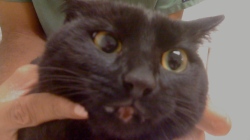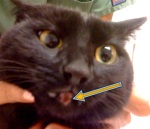Feline Eosinophilic Granuloma Complex
 What is That Painful-Looking Red Wound on my Cat’s Lip?
What is That Painful-Looking Red Wound on my Cat’s Lip?
“Feline eosinophilic granuloma complex,” said Doc Truli.
“What?” said Shadow’s mom.
“Do you want the $20 name, or the $200 name for that red, ulcerated sore area on your cat’s lower lip,” said Doc Truli.
“Umm. That was the $200 word, right? How about you explain that in people-talk,” said Shadow the cat’s mom.
A two-year-old female spayed black cat with big golden eyes looked up at Doc Truli. Though Shadow was confident and beautiful, she sported a giant raw, red ulcerated, slightly oozing wound near the middle of her lower lip.
Diagnosing Feline Eosinophilic Granuloma Complex (EGC)
No signs of any other skin sores or lesions. Otherwise healthy cat. Feline leukemia and Feline AIDs virus negative. No foreign objects like a stinger or plant awn stuck on the sore. No history or signs of trauma or injury. Doc Truli placed a clean, new microscope slide with a special tacky adhesive layer on the skin, stained the sample, and examined the results microscopically.
“There are just wall-to-wall eosinophils in here,” said the Doc. (Pronounced ee-oh-sin-oh-fills)
“What does that mean?”
“It means there is not pus, like from an infection, or lymph cells, like a skin cancer, there are these red granules (eos- is a prefix for red in Greek) inside the immune cells. These cells react to allergies and parasites. In some cats, these eosinophils like to congregate somewhere on the skin and cause itchy, red, sore, ulcerated areas. The condition has been given the name “Eosinophilic Granuloma Complex,” said Doc Truli.
“Rodent Ulcer is a common alternative name for the eosinophilic granuloma wound that spontaneously forms on the lip of an affected cat. It is not contagious. It does not come from a rodent. I have no idea why it’s called a Rodent Ulcer!” says Doc Truli.
To truly diagnose EGC, your veterinarian must biopsy the area. A small piece of your cat’s sore skin gets removed, surgically, sometimes under local anesthesia, usually under general anesthesia, and sent for processing and interpretation by a pathology specialist familiar with feline dermatology. As the condition is not thought to affect internal organs and the treatment is inexpensive and fairly benign, your veterinarian may skip the biopsy to avoid further injury to your cat.
What Else Can EGC Look Like?
Round, flat, sometimes irregular plaque-like sores that can be very itchy pop up for no visible reason on your cat’s lip, down the spine, down the back on the hind legs, and sometimes on the belly and underarms. Ringworm fungus, bacterial infection, food allergies, cutaneous (skin) lymphoma and various other diseases can resemble EGC; you will need a veterinarian, especially because some infections, like ringworm are contagious to people, your kids, and your other pets.
Will the EGC Go Away?
Yes! The basic treatment involves steroids of some sort. Steroids may cause temporary diabetes mellitus, or can unmask hidden heart disease and throw your cat into heart failure (check with your veterinarian). But generally, cats tolerate steroids like methyl prednisolone and triamcinolone and prednisolone very well. The wound will disappear almost magically.
Allopathic medicine – by which Doc Truli means “modern, Western, US-style, University of Pennsylvania medicine – gives no reasons why some cats get these red sores. Perhaps allergies affect some cats causing the eosinophils to go nutty and aggregate into painful red lumps. Let Doc Truli tell you about her personal cat who suffered EGC, waxy ears, and full anal sacs constantly.
“My little white barn cat, Minga, constantly needed ear cleaning and anal sac expression for the first two years of her life. Then Minga developed a nasty red, ulcerated sore that covered half her lower lip. I had read somewhere that allergies could trigger a rodent ulcer – so I thought and thought until I had an idea. Minga loved fresh catnip from the plant growing on the porch. She would go over to the closed wooden front door, paw the door, and then sit up like a begging bunny to be allowed on the porch. Minga scored catnip almost every day with this adorable routine!
Then a light went on in my brain – I knew that people often crave foods they are allergic or sensitive to – like popcorn, or sugar, or white flour. I thought, what if Minga is allergic to catnip? So we experimented. No catnip for a month.
After no catnip for a month, the lip healed, the ears stayed clean, and her little butt situation stopped bothering her. But, the scientific part of any great experiment is the test of the theory. After a month, I gave her catnip.
The very next morning, her anal sacs were full, butt red, ear canals coated with medium brown oily wax, and the sore returned to her lip! Minga did not need steroids! The little white cat needed to lay off the fresh nipper!”
How to Investigate a Cat’s Potential Allergy
Your cat may not be so clear-cut to figure out. Here are some allergy detection tips for cats:
- Be certain to use non-plastic dishes.
- Use fresh, clean water.
- Rinse the soap residue very well after washing the dishes.
- If you change basics like the litter, only try one new thing a week.
- If the change helps, go back to the old way the next week to see if the symptoms return!
- Be suspicious of new bedding, especially wool or polyester.
- Talk with your veterinarian about hypoallergenic food. 10% of cat allergies are food allergies. Again, after the 8 week food trial, if it is working, you must go back to the old food for 3-4 days to confirm the allergy.
EGC Resolution
Shadow received a long-acting steroid shot. The sore went away on 5 days. Because EGC is not primarily an infection, all the Triple Antibiotic cream in the world was never going to work. It just annoyed the poor cat! Make your cat happy as quickly as possible by consulting your veterinarian!




Excellent post, very informative and ‘accessible’ to cat servants, too!
Thank you for the feedback, Teri, although, admittedly, you are no ordinary cat servant!